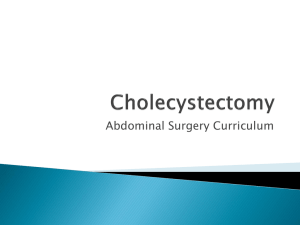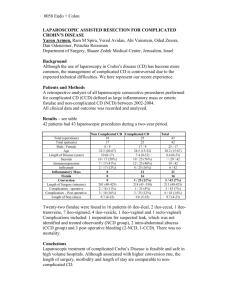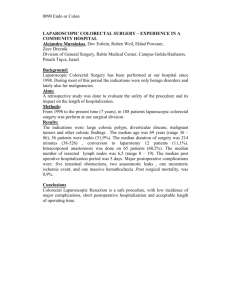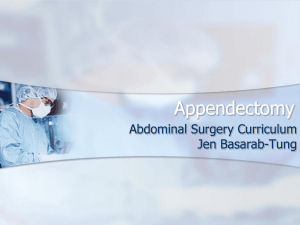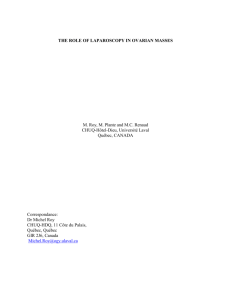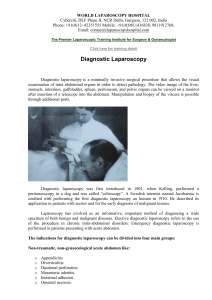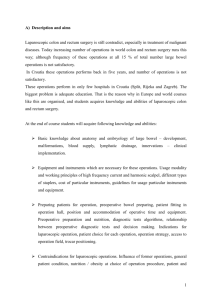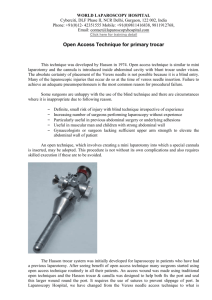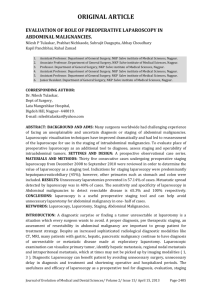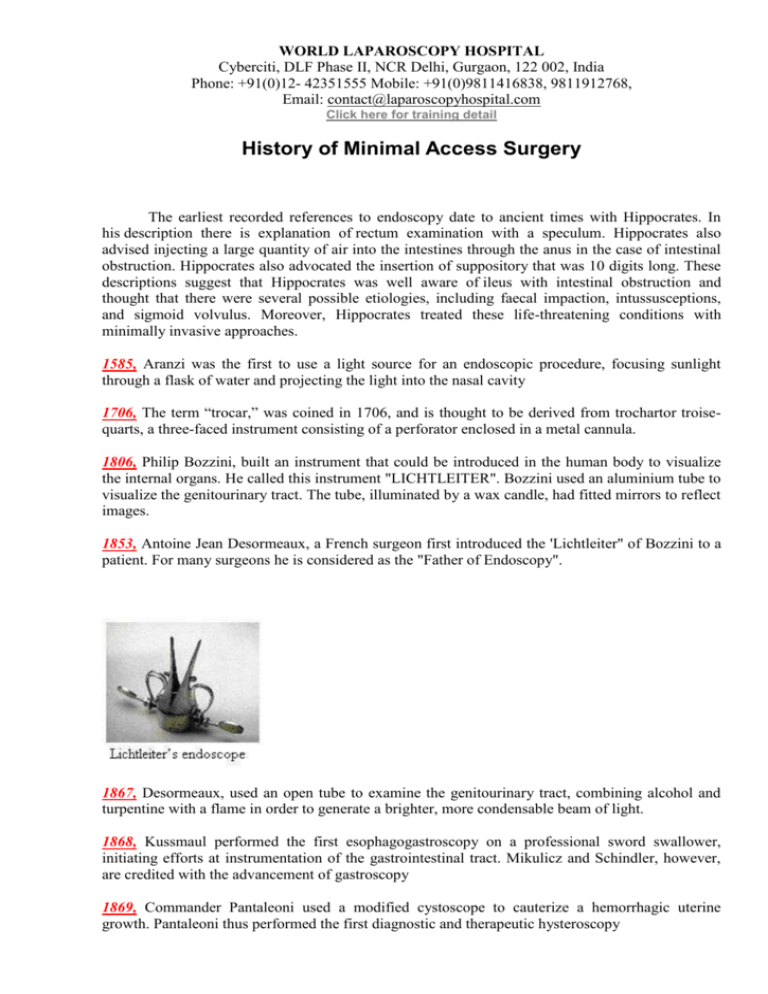
WORLD LAPAROSCOPY HOSPITAL
Cyberciti, DLF Phase II, NCR Delhi, Gurgaon, 122 002, India
Phone: +91(0)12- 42351555 Mobile: +91(0)9811416838, 9811912768,
Email: contact@laparoscopyhospital.com
Click here for training detail
History of Minimal Access Surgery
The earliest recorded references to endoscopy date to ancient times with Hippocrates. In
his description there is explanation of rectum examination with a speculum. Hippocrates also
advised injecting a large quantity of air into the intestines through the anus in the case of intestinal
obstruction. Hippocrates also advocated the insertion of suppository that was 10 digits long. These
descriptions suggest that Hippocrates was well aware of ileus with intestinal obstruction and
thought that there were several possible etiologies, including faecal impaction, intussusceptions,
and sigmoid volvulus. Moreover, Hippocrates treated these life-threatening conditions with
minimally invasive approaches.
1585, Aranzi was the first to use a light source for an endoscopic procedure, focusing sunlight
through a flask of water and projecting the light into the nasal cavity
1706, The term “trocar,” was coined in 1706, and is thought to be derived from trochartor troisequarts, a three-faced instrument consisting of a perforator enclosed in a metal cannula.
1806, Philip Bozzini, built an instrument that could be introduced in the human body to visualize
the internal organs. He called this instrument "LICHTLEITER". Bozzini used an aluminium tube to
visualize the genitourinary tract. The tube, illuminated by a wax candle, had fitted mirrors to reflect
images.
1853, Antoine Jean Desormeaux, a French surgeon first introduced the 'Lichtleiter" of Bozzini to a
patient. For many surgeons he is considered as the "Father of Endoscopy".
1867, Desormeaux, used an open tube to examine the genitourinary tract, combining alcohol and
turpentine with a flame in order to generate a brighter, more condensable beam of light.
1868, Kussmaul performed the first esophagogastroscopy on a professional sword swallower,
initiating efforts at instrumentation of the gastrointestinal tract. Mikulicz and Schindler, however,
are credited with the advancement of gastroscopy
1869, Commander Pantaleoni used a modified cystoscope to cauterize a hemorrhagic uterine
growth. Pantaleoni thus performed the first diagnostic and therapeutic hysteroscopy
1901, Dimitri Ott, a Petrograd gynecologist wore head mirrors to reflect light and augment
visualization and used access technique in which a speculum was introduced through an incision in
the prior vaginal fornix in a pregnant woman.
1901, The first experimental laparoscopy was performed in Berlin in 1901 by this German surgeon
Georg Kelling, who used a cystoscope to peer into the abdomen of a dog after first insufflating it
with air. Kelling also used filtered atmospheric air to create a pneumoperitoneum, with the goal of
stopping intra-abdominal bleeding (Ectopic pregnancy, bleeding ulcers, and pancreatitis) but these
studies did not find any response or supporters.
Kelling performing Laparoscopy in Dog
Kelling proposed a high-pressure insufflation of the abdominal cavity, a technique he called the
"Luft-tamponade" or "air-tamponade".
1910, H.C. Jacobaeus of Stockholm published a discussion of the inspection of the peritoneal,
pleural and pericardial cavity.
1911, Bertram M. Bernheim, from Johns Hopkins Hospital introduced first laparoscopic surgery
to the United States. He named the procedure of minimal access surgery as "organoscopy". The
instrument used was a proctoscope of a half inch diameter and ordinary light for illumination was
used.
1911, H.C. Jacobaeus, again coined the term "laparothorakoskopie" after using this procedure on
the thorax and abdomen. He used to introduce the trocar inside the body cavity directly without
employing a pneumoperitoneum.
1918, O. Goetze, developed an automatic pneumoperitoneum needle characterized for its safe
introduction to the peritoneal cavity.
The next decade and a half saw an interruption of technological advances and a lack of any
substantial development in endoscopy due to World War I.
1920, Zollikofer of Switzerland discovered the benefit of CO2 gas to use for insufflation, rather
than filtered atmospheric air or nitrogen.
1929, Kalk, a German physician, introduced the forward oblique (135 degree) view lens systems.
He advocated the use of a separate puncture site for pneumoperitoneum. Goetze of Germany first
developed a needle for insufflations.
1929, Heinz Kalk, a German gastroenterologist developed a 135 degree lens system and a dual
trocar approach. He used laparoscopy as a diagnostic method for liver and gallbladder disease.
1934, John C. Ruddock, an American surgeon described laparoscopy as a good diagnostic method,
many times, superior than laparotomy. John C. Ruddock used the instrument for diagnostic
laparoscopy which consisted a built-in forceps with electro coagulation capacity.
1936, Boesch of Switzerland is credited for doing the first laparoscopic tubal sterilization
1938, Janos Veress of Hungary developed a specially designed spring-loaded needle. Interestingly,
Veress did not promote the use of his Veress needle for laparoscopy purposes. He used veress
needle for the induction of pneumothorax. Veress needle is the most important instrument today to
create pneumo-peritoneum.
Veress needle
Veress needle consists of an outer cannula with a beveled needle point for cutting through tissues.
Inside the cannula of verses needle is an inner stylet, stylet is loaded with a spring that spring
forward in response to the sudden decrease in pressure encountered upon crossing the abdominal
wall and entering the peritoneal cavity.
1939, Richard W. Telinde, tried to perform an endoscopic procedure by a culdoscopic approach, in
the lithotomy position. This method was rapidly abandoned because of the presence of small
intestine.
1939, Heinz Kalk published his experience of 2000 liver biopsies performed using local anaesthesia
without mortality.
1944, Raoul Palmer, of Paris performed gynaecological examinations using laparoscopy and
placing the patients in the Trendelenberg position, so air could fill the pelvis. He also stressed the
importance of continuous intra-abdominal pressure monitoring during a laparoscopic procedure.
1953, The rigid rod lens system was discovered by Professor Hopkins. The credit of videoscopic
surgery goes to this surgeon who has revolutionized the concept by making this instrument.
Laparoscope
1960, Kurt Semm, a German gynaecologist, who invented the automatic insufflator. His experience
with this new device was published in 1966. Although not recognized in his own land, on the other
side of the Atlantic, both American physicians and instrument makers valued the Semm’s
insufflator for its simple application, clinical value, and safety.
First Insufflator made by Prof. Semm
1960, British Gynaecologist Patrick Steptoe adapted the techniques of sterilization by two puncture
technique.
1966, Kurt Semm introduced an automatic insufflation device capable of monitoring intraabdominal pressures. This reduced the dangers associated with insufflation of the abdomen and
allowed safer laparoscopy.
1970, Gynaecologists had embraced laparoscopy and thoroughly incorporated the technique into
their practice. General surgeons, despite their exposure to laparoscopy remained confined to
traditional open surgery.
1972, H.Coutnay Clarke first time showed laparoscopic suturing technique for hemostasis.
1973, Gaylord D. Alexander developed techniques of safe local and general anaesthesia sitable for
laparoscopy.
1977, First Laparoscopic assisted appendicectomy was performed by Dekok. Appendix was
exteriorized and ligated outside.
1977, Kurt Semm first time demonstrated endoloop suturing technique in laparoscopic surgery.
1978, Hasson introduced an alternative method of trocar placement. He proposed a blunt minilaparotomy which permits direct visualization of trocar entrance into the peritoneal cavity.
Hassons Cannula
A reusable device of similar design to a standard cannula but attached to an olive-shaped sleeve
was developed by Hasson. This sleeve would slide up and down the shaft of the cannula and would
form an airtight seal at the fascial opening. In addition, the sharp trocar was replaced by a blunt
obturator. This cannula is held in place by the use of stay sutures passed through the fascial edges
and attached to the body of the cannula.
1980, In United Kingdom Patrick Steptoe, started to perform laparoscopic procedures.
1983, Semm, a German gynaecologist, performed the first laparoscopic appendicectomy.
1985, The first documented laparoscopic cholecystectomy was performed by Erich Mühe in
Germany in 1985.
1987, Ger reported first laparoscopic repair of inguinal hernia using prototype stapeler.
1987, Phillipe Mouret, has got the credit to perform the first laparoscopic cholecystectomy in
Lyons, France using video technique. Cholecystectomy is the laparoscopic procedure which
revolutionized the general surgery.
Robotic arm
1988, Harry Reich performed laparoscopic lymphadenectomy for treatment of ovarian cancer.
1989, Harry Reich described first laparoscopic hysterectomy using bipolar dessication; later he
demonstrated staples and finally sutures for laparoscopic hysterectomy.
1989, Reddick and Olsen reported that CBD injury after laparoscopic cholecystectomy is 5 times
that with conventional cholecystectomy. As a result of this report USA government announced that
surgeons should do at least 15 laparoscopic cholecystectomy under supervision before being
allowed to do this procedure on their own.
1990, Bailey and Zucker in USA popularized laparoscopic anterior highly selective vagotomy
combined with posterior truncal vagotomy.
1994, A robotic arm was designed to hold the telescope with the goal of improving safety and
reducing the need of skilled camera operator.
1996, First live telecast of laparoscopic surgery performed remotely via the Internet. (Robotic
Telesurgery).
Trans-Atlantic Minimal Access Surgery
For More Information Contact:
Laparoscopy Hospital
Unit of Shanti Hospital, 8/10 Tilak Nagar, New Delhi, 110018. India.
Phone:
+91(0)11- 25155202
+91(0)9811416838, 9811912768
Email: contact@laparoscopyhospital.com
Copyright © 2001 [Laparoscopyhospital.com]. All rights reserved.
Revised:
.


